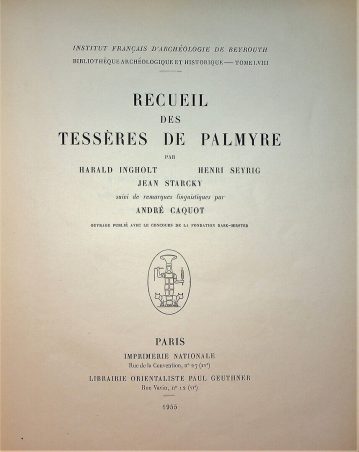Recueil des Tessères de Palmyre.
Ingholt, Harald / Henri Seyrig & Jean Starcky.
Synopsis
Scholarly monograph on the tesserae (token) found in Palmyra, an ancient city in south-central Syria, built on an oasis lying halfway between the Mediterranean Sea, and the Euphrates River, thus helping to connect the Roman world with Mesopotamia and the East. The tesserae were distributed as gifts by the Roman emperor or local government, often to the poor, and used as vouchers to exchange for grain, oil, or other goods. Some may have even been used as small change coinage.The tesserae of Palmyra are a large assemblage of approximately 1,500 objects. The greater part is in the National Museum of Syria, Damascus and originates from excavations carried out in Palmyra, from surveys in the city outskirts and private collections. They are almost exclusively ceramic. A handful are made of copper, glass, lead and iron. Most of them bear an image on both sides, while very few on only one. Their shapes come in an exceptionally large variety which includes tokens resembling spears, leaves, crescents, temples, alters, funerary steles, Arabian shields, rectangles, polygons, circles, etc. They were made of different coloured clay due to natural minerals.








